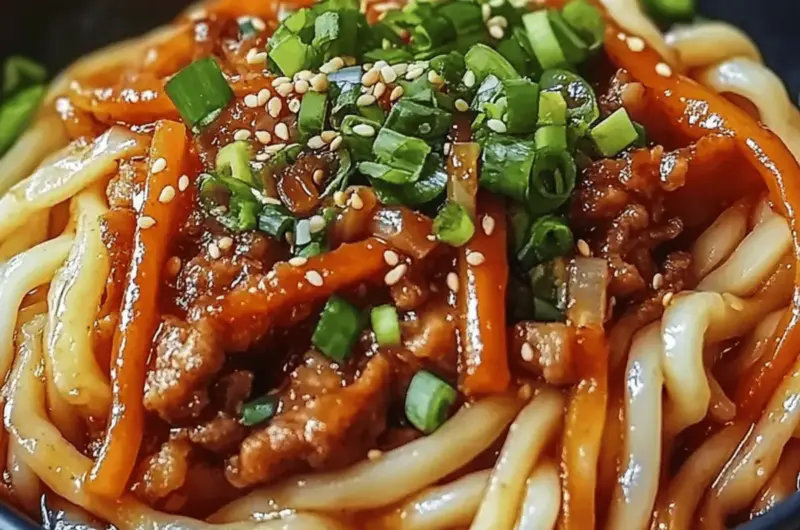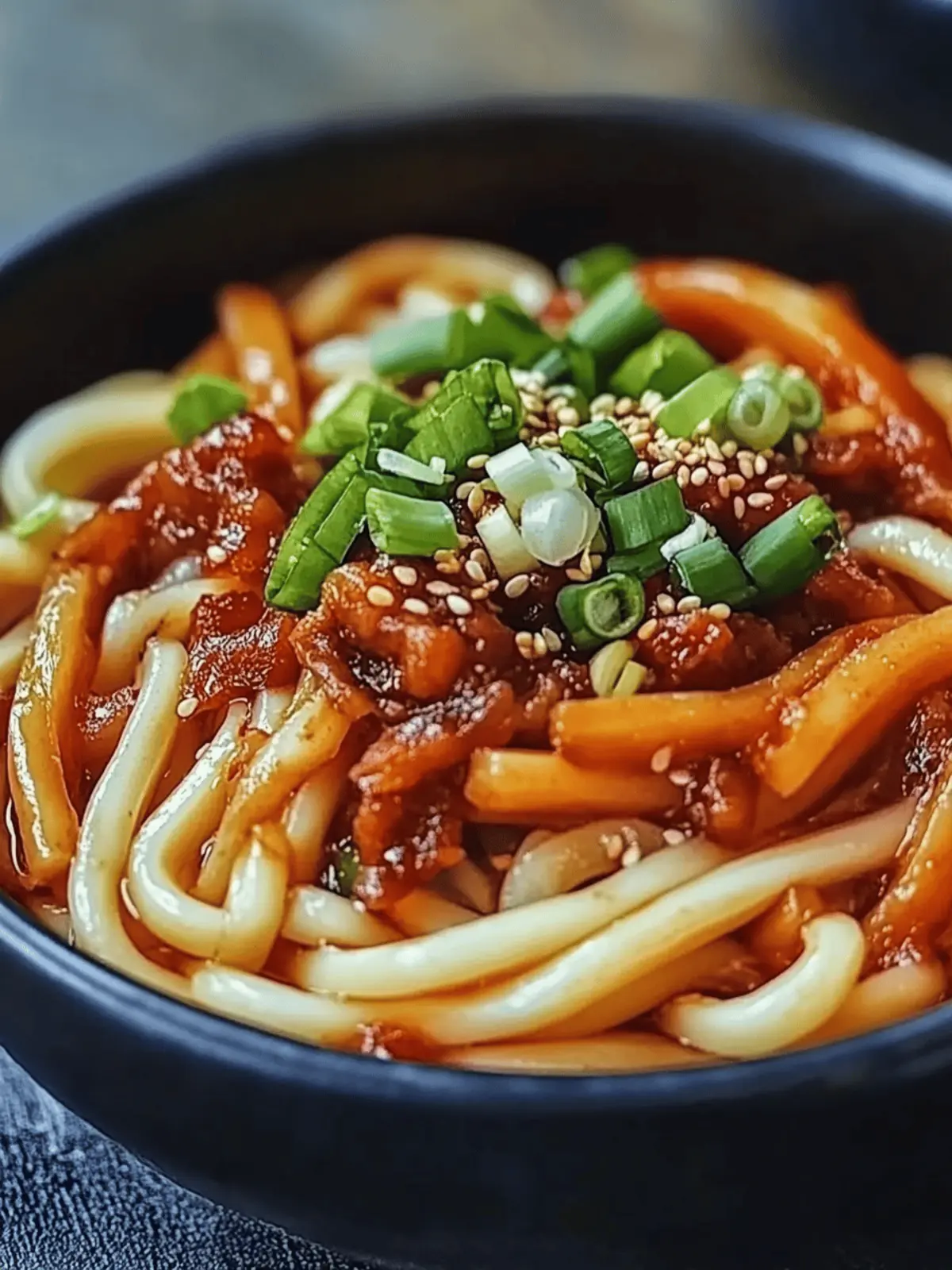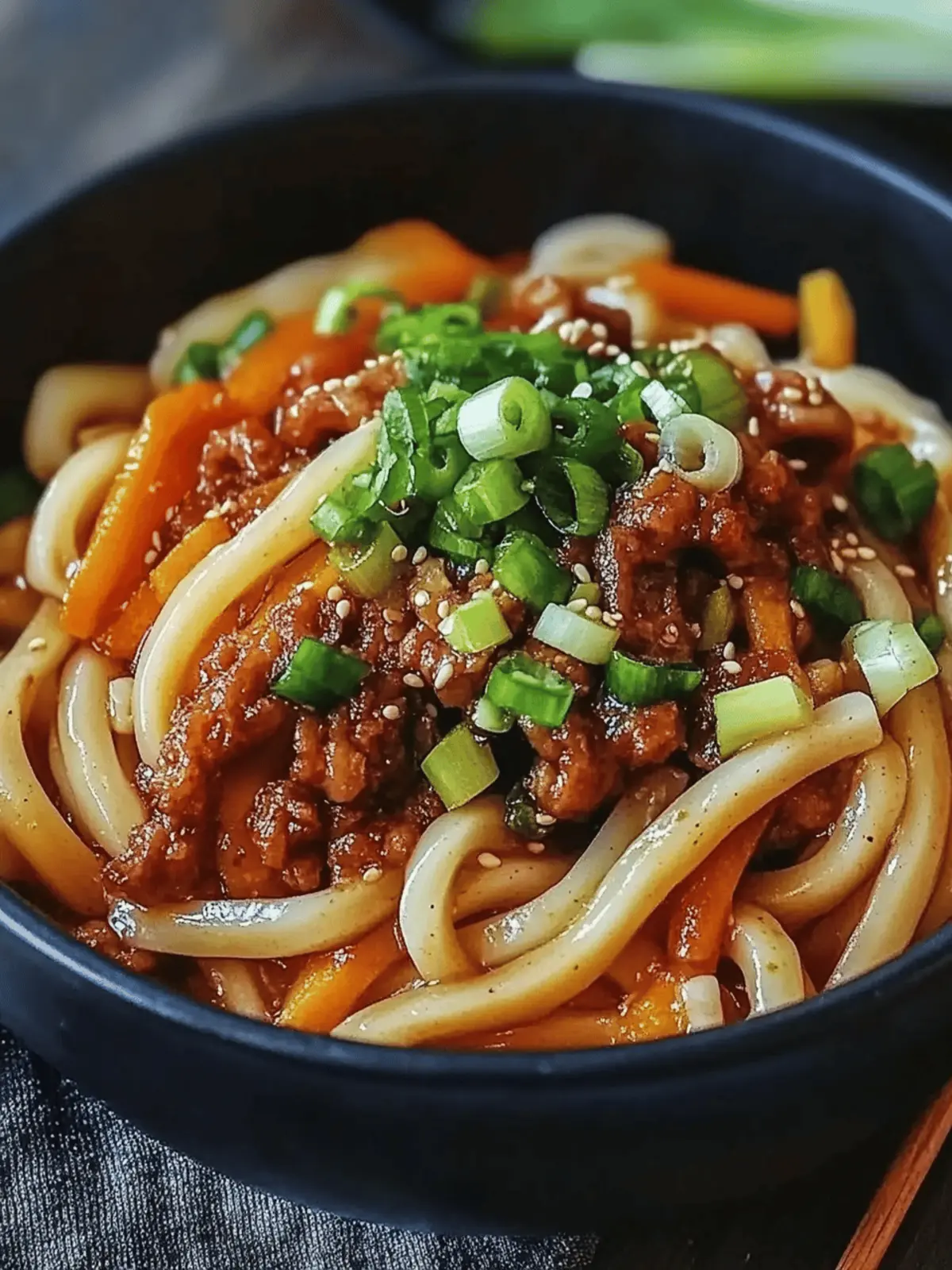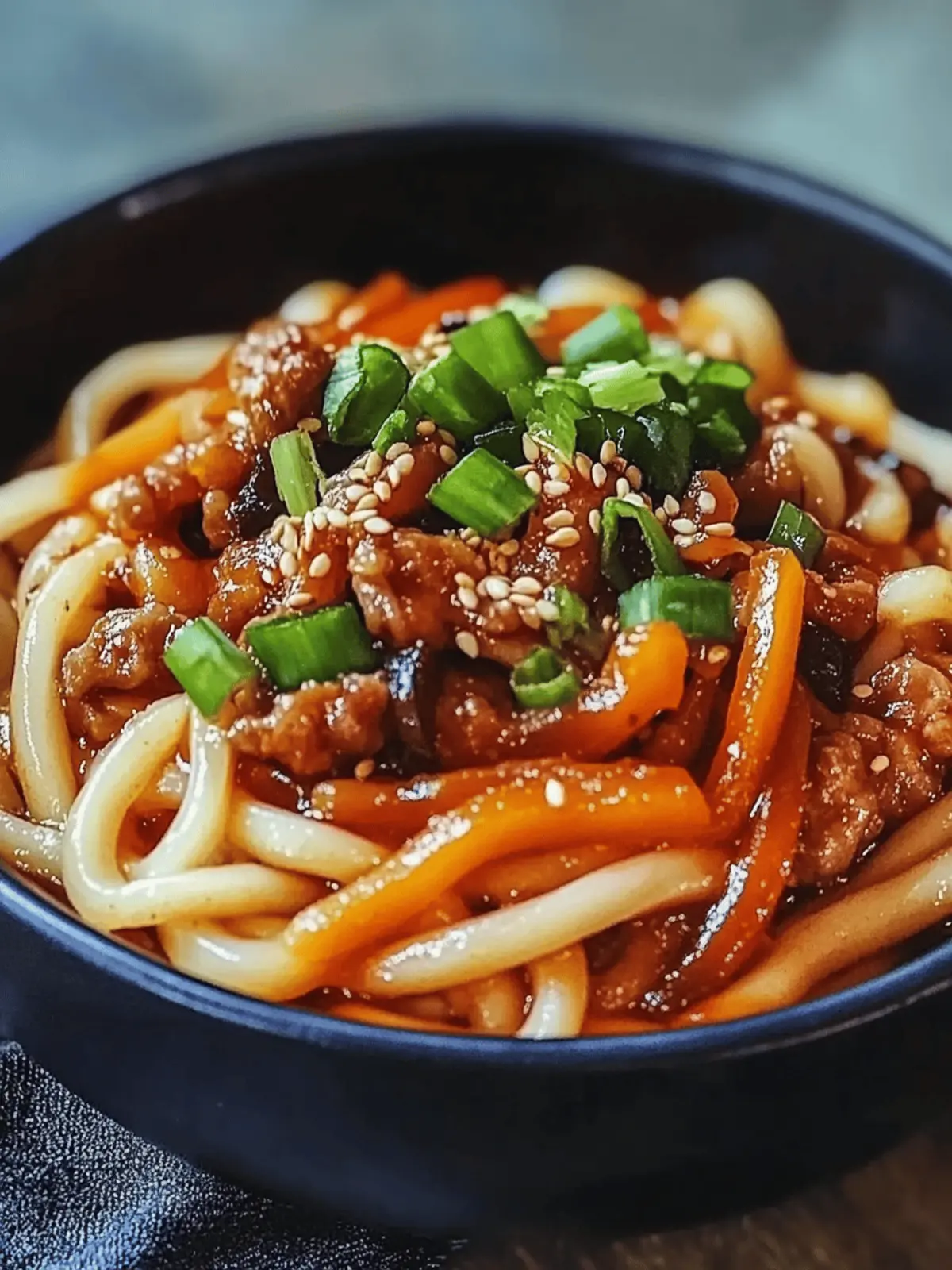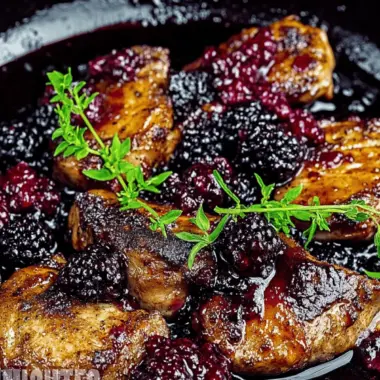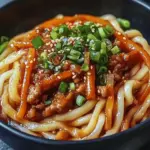There’s something truly captivating about the way different cuisines can dance together on a plate. When I first combined the bold, smoky flavors of bulgogi with the comforting, chewy texture of udon noodles, I realized I stumbled upon a delicious fusion that would soon become a family favorite. This Bulgogi Pork Udon not only satisfies my craving for a hearty meal but is also effortlessly customizable—perfect for those busy weeknights when you want something nourishing without the fuss of takeout.
With its savory, marinated pork and a hint of spice from gochujang, this dish strikes a beautiful balance of flavors and textures, elevating your home-cooked meals to new heights. Whether you prefer to keep it classic or toss in your favorite veggies, this recipe adapts to your taste, ensuring that every bowl is a little different yet equally delightful. Join me on this culinary adventure, and let’s discover the magic that happens when Korean and Japanese flavors unite!
Why is Bulgogi Pork Udon so irresistible?
Bold flavors come together in a delightful fusion, creating a dish that excites your taste buds. Customizable options ensure that everyone can enjoy it their way—substitute proteins or toss in seasonal veggies for a unique twist. Quick prep time makes this the ultimate weeknight solution when cravings strike! Comforting texture from the udon noodles pairs perfectly with tender, marinated pork, resulting in a satisfying meal. Plus, it’s a crowd-pleaser, ideal for family gatherings or impressing dinner guests. For even more delicious ideas, check out more comforting recipes.
Bulgogi Pork Udon Ingredients
For the Marination
• Pork Shoulder or Pork Belly – Main protein; offers tenderness and rich flavor. Can substitute with chicken, beef, or tofu for variety.
• Gochujang – Korean red chili paste; adds a spicy and savory depth. Use mild chili paste for a lesser heat level.
• Gochugaru – Korean chili flakes; enhances spiciness and color. No direct substitute; use more mild red pepper flakes if unavailable.
• Soy Sauce – Provides umami and saltiness. Low-sodium soy sauce serves as a healthier option.
• Rice Wine (Mirin) – Adds sweetness and complexity. Substitute with white wine or a touch of sugar for sweetness.
• Sugar and Honey – Sweeteners that balance flavors. Agave syrup or maple syrup can work for a different flavor profile.
• Sesame Oil – Adds nuttiness and richness. Omit if necessary as there’s no ideal substitute.
• Minced Garlic and Grated Ginger – Aromatics that enhance flavor. For convenience, garlic powder and ginger powder can be used.
For the Noodles and Vegetables
• Udon Noodles – Base of the dish; gives a chewy texture. Soba noodles or rice noodles can also be used for variations.
• Vegetables (onions, carrots, bell peppers, scallions) – Adds nutrition and color. Any desired vegetables like zucchini, mushrooms, or bok choy are acceptable.
• Apple (grated, optional) – Adds sweetness and moisture. Pear can be used for a similar sweetness.
For the Garnish
• Sesame Seeds – For garnish; adds crunch and flavor. Omit based on personal preference.
Each ingredient plays a vital role in creating the unforgettable experience that is Bulgogi Pork Udon. So gather your ingredients and let’s get cooking!
How to Make Bulgogi Pork Udon
-
Marinate the Pork: In a bowl, mix together the gochujang, soy sauce, sugar, honey, sesame oil, minced garlic, grated ginger, and optional grated apple. Coat the sliced pork thoroughly and let it marinate for at least 30 minutes, preferably overnight for maximum flavor.
-
Cook Udon Noodles: Follow the package instructions to prepare the udon noodles, usually boiling them for around 8-10 minutes. Once cooked, drain and set aside to keep them from sticking together.
-
Stir-Fry the Pork: Heat a skillet over medium-high heat and add the marinated pork. Stir-fry until the pork is caramelized and cooked through, about 5-7 minutes. Remove from the skillet and let it rest.
-
Sauté Vegetables: In the same skillet, add a bit of oil if needed and sauté the onions, carrots, and bell peppers until they are tender-crisp, about 3-4 minutes.
-
Combine: Return the cooked pork to the skillet along with the udon noodles. Toss everything together until well mixed and heated through, ensuring all the ingredients are coated in the flavorful sauce.
-
Serve: Divide the bulgogi pork udon into bowls, and garnish with chopped scallions and a sprinkle of sesame seeds for an extra touch. Serve hot and enjoy your homemade fusion delight!
Optional: Add a dash of lime juice before serving for a zesty kick.
Exact quantities are listed in the recipe card below.
How to Store and Freeze Bulgogi Pork Udon
Fridge: Store leftovers in an airtight container in the refrigerator for up to 3 days. This keeps the flavors fresh while maintaining the tender pork and chewy udon noodles.
Freezer: For longer storage, freeze the cooked Bulgogi Pork Udon in a freezer-safe container for up to 2 months. To avoid freezer burn, wrap tightly in plastic wrap before placing in a container.
Reheating: When ready to enjoy, thaw in the refrigerator overnight, then reheat gently in a skillet over medium heat to preserve texture. You can add a splash of water or broth to loosen the noodles if needed.
Leftover Tips: If you have extra marinated pork, it can also be frozen in its marinade for up to 2 months. This way, you can enjoy quick and flavorful meals in a hurry!
What to Serve with Bulgogi Pork Udon?
Elevate your dining experience with thoughtful pairings that complement the rich flavors of this delightful dish.
-
Kimchi: A staple Korean side dish, kimchi adds a spicy, tangy crunch that balances the savory notes of the udon.
-
Cucumber Salad: This refreshing salad brightens the palate with its cool crunch, making each bite of udon feel vibrant and lively.
-
Pickled Radishes: The crispy, slightly sweet tartness of pickled radishes contrasts beautifully with the richness of the bulgogi, enhancing every mouthful.
-
Sesame Spinach: Lightly seasoned with sesame oil, this side dish provides a nutty flavor and adds a healthy green touch to your meal.
-
Miso Soup: The warm, umami-rich broth of miso soup creates a cozy vibe, preparing your taste buds for the savory adventure of your main dish.
-
Green Tea: A calming beverage option, green tea complements the flavors of bulgogi pork udon, helping to cleanse the palate between bites.
For dessert, consider serving Mochi Ice Cream; its chewy texture and sweet flavors create a delightful finish to your meal.
Make Ahead Options
Bulgogi Pork Udon is perfect for meal prep enthusiasts looking to save time during busy weeknights! You can marinate the pork up to 24 hours in advance, coating it thoroughly in the marinade to deepen the flavors. Additionally, you can cook the udon noodles and sauté the vegetables up to 3 days ahead, storing them separately in airtight containers in the refrigerator to maintain their texture. When you’re ready to serve, simply stir-fry the marinated pork until caramelized, then combine everything in the skillet to heat through. This way, you’ll enjoy delicious, restaurant-quality Bulgogi Pork Udon with minimal effort!
Expert Tips for Bulgogi Pork Udon
- Marinating Time: For the juiciest and most flavorful pork, let it marinate overnight if you can. It makes a world of difference!
- Noodle Caution: Don’t overcook the udon noodles; follow package instructions carefully to avoid mushiness. They should remain chewy!
- Taste as You Go: Before adding the pork to the marinade, give it a taste. Adjust gochujang or gochugaru according to your heat tolerance.
- Veggie Swap: Feel free to mix and match vegetables! Broccoli and snap peas are fantastic additions that add nutrients and crunch.
- Proper Heat: Ensure your skillet is hot enough when stir-frying the pork to achieve that perfect caramelization. This enhances flavor and texture!
Bulgogi Pork Udon Variations
Unleash your creativity with these delightful twists to elevate your meal.
- Dairy-Free: Swap any dairy-based sauces for coconut aminos for a gentle, sweet flavor profile.
- Spicy Kick: Add fresh sliced jalapeños or a sprinkle of red pepper flakes for an extra heat.
- Soba Twist: Substitute udon with soba noodles for a nutty taste and a slightly different texture.
- Vegetable Boost: Toss in bok choy or snow peas to increase crunch and nutrition—perfect for vibrant color!
- Asian Flair: Drizzle with a little hoisin sauce before serving to introduce a sweet, rich flavor.
- Protein Variety: Use beef strips, tofu, or chicken thighs instead of pork; each offers a unique appeal that caters to different tastes.
- Tangy Zing: A splash of rice vinegar or lime juice just before serving can brighten everything on your plate!
- Hearty Addition: Include shiitake mushrooms or extra veggies like zucchini for a robust bite and added nutrients.
Bulgogi Pork Udon Recipe FAQs
How do I choose the best pork for Bulgogi Pork Udon?
For the most tender and flavorful result, I recommend using pork shoulder or pork belly. Look for cuts that have a good amount of marbling, as this will contribute richness and juiciness when cooked. If you prefer leaner options, chicken thighs or beef strips can also work wonderfully. Just ensure that whatever protein you select is fresh and of high quality.
How should I store leftovers of Bulgogi Pork Udon?
Simply store your leftovers in an airtight container in the refrigerator for up to 3 days. It’s best to reheat them gently in a skillet over medium heat to maintain the texture of the udon noodles. If you find they’re sticking together, add a splash of water or broth while reheating.
Can I freeze Bulgogi Pork Udon?
Absolutely! You can freeze your cooked Bulgogi Pork Udon in a freezer-safe container for up to 2 months. To prevent freezer burn, wrap it tightly in plastic wrap before placing it in a container. When you’re ready to enjoy, thaw it in the refrigerator overnight and reheat in a skillet over medium heat.
What should I do if my udon noodles are mushy?
To avoid mushy udon noodles, make sure to follow package instructions for cooking time closely, which is usually around 8-10 minutes. Aim for al dente; they should be chewy but cooked through. If they’ve already become mushy, try tossing them quickly in cold water after draining to halt the cooking process.
Can I make Bulgogi Pork Udon vegetarian or gluten-free?
Certainly! You can replace the pork with tofu or tempeh for a vegetarian option. For gluten-free, look for gluten-free udon noodles or substitute with rice noodles. Just be mindful that the seasoning and sauce may need adjustments; use gluten-free soy sauce to keep it delicious while accommodating dietary restrictions.
What if I’m sensitive to spicy foods, can I adjust the heat level?
Very much so! If you’re sensitive to spice, start with less gochujang (Korean red chili paste) in your marinade and gradually add more until reaching your desired flavor. You can also use a mild chili paste or completely omit the gochugaru (Korean chili flakes) to keep things on the milder side while still enjoying the fusion of flavors in Bulgogi Pork Udon.
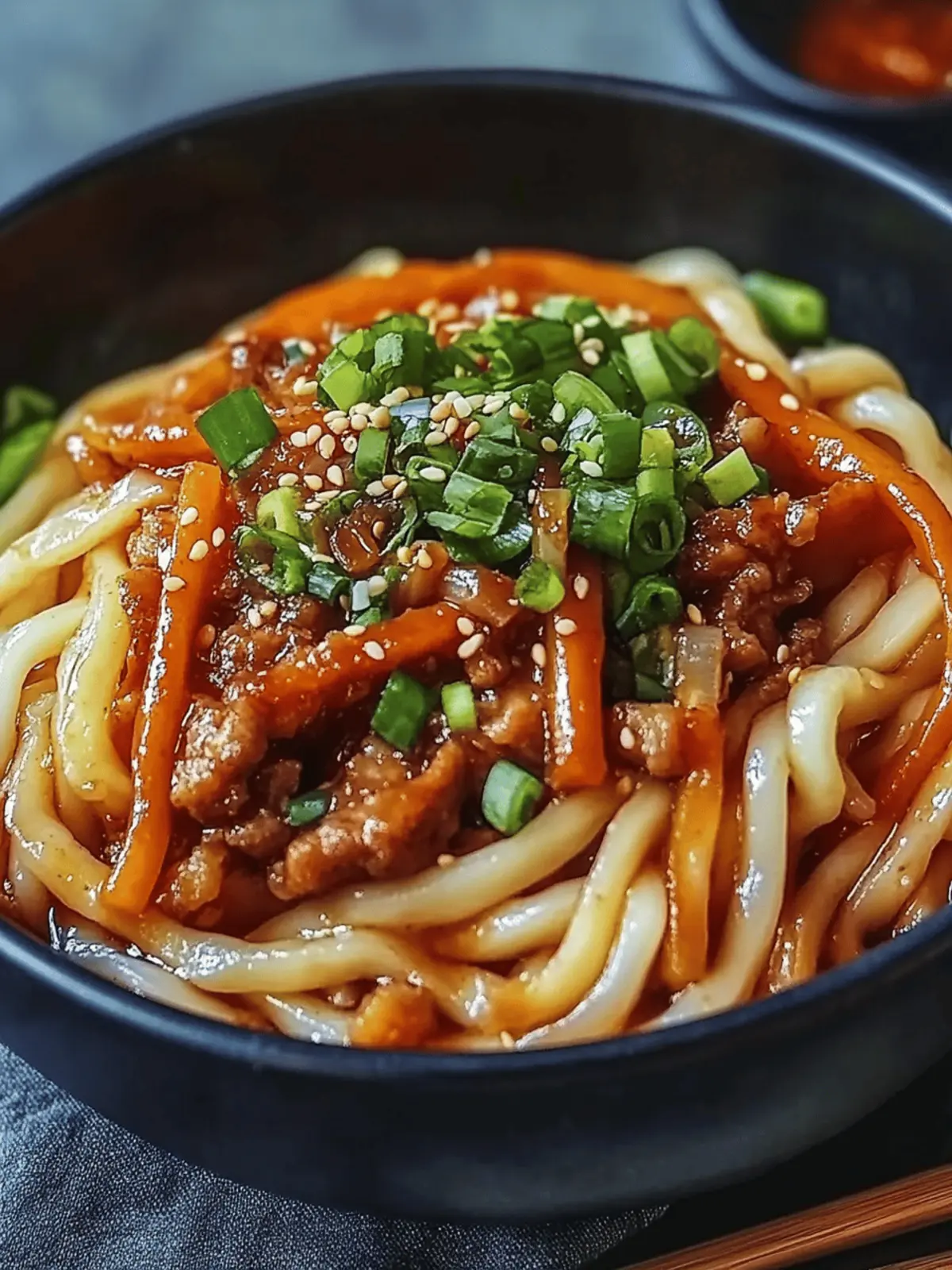
Bulgogi Pork Udon: A Flavor-Packed Comfort Meal at Home
Ingredients
Equipment
Method
- In a bowl, mix together gochujang, soy sauce, sugar, honey, sesame oil, minced garlic, grated ginger, and optional grated apple. Coat pork and marinate for at least 30 minutes.
- Follow package instructions to prepare udon noodles, usually boiling for 8-10 minutes. Drain and set aside.
- Heat a skillet over medium-high heat and add marinated pork. Stir-fry until caramelized and cooked through, about 5-7 minutes. Remove and let rest.
- In the same skillet, add oil if needed and sauté onions, carrots, and bell peppers until tender-crisp, about 3-4 minutes.
- Return cooked pork to skillet with udon noodles. Toss together until well mixed, ensuring all ingredients are coated in sauce.
- Divide bulgogi pork udon into bowls, garnish with scallions and sesame seeds, and serve hot.

